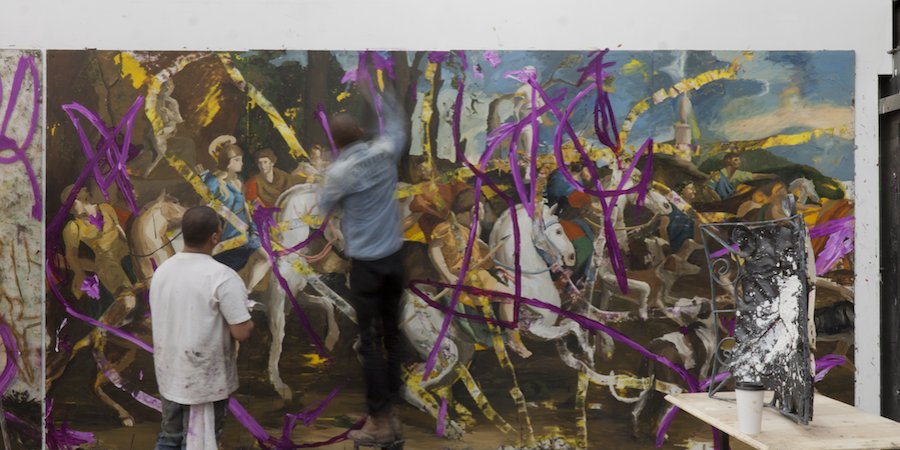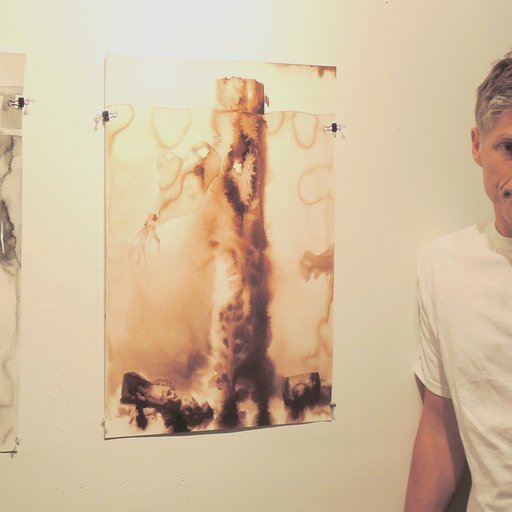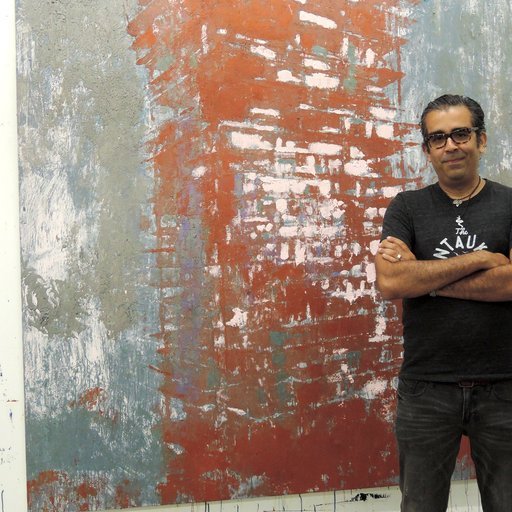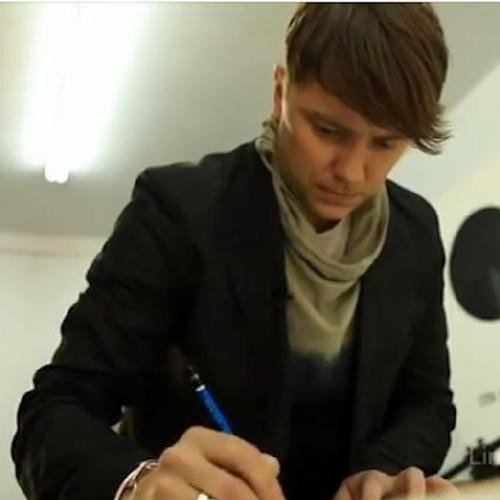The Puerto-Rican born artist Angel Otero has emerged in the last few years as one of the most coveted painters of his generation, garnering wait lists of collectors who hope to acquire one of the edgily idiosyncratic canvases that, through a complex and time-consuming process, he endows with seductively billowing ripples and waves of paint. In advance of his new show at Lehmann Maupin Gallery , which debuted both a new series of paintings and a previously little-seen body of sculptures (one of which made an appearance at last year's EXPO CHICAGO ), we took a trip to the artist's workmanlike studio in Bushwick to hear Otero explain his unique approach to the age-old medium of painting. Here's what he had to say.
THE PROCESS 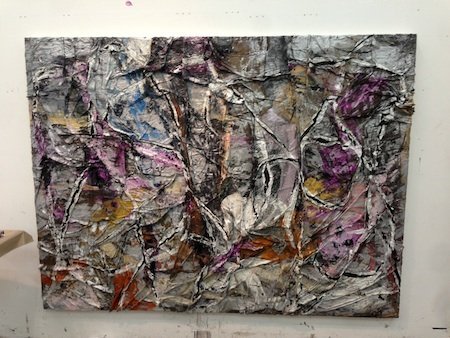
I create my paintings in a very traditional way, you might say, using oil paints and brushes and palates and standing up in a very conventional way, but I do all of this on a Plexiglas surface, not a canvas. They reference a lot of classical issues about painting, and lately I’ve been making reproductions of classical paintings by Poussin—I tend to focus on a single artist per series. In one you can see is a pastoral landscape inspired by Poussin, and here you see a couple at the bottom. Then, when the painting is finished, I take the glass off the wall and I cover it with very thick layers of oil paint in a series of gestural marks, so it's almost like painting in reverse—first I paint the scene, and then I cover it with the background.
PUTTING THE PAINT ON CANVAS
After that, I put the painting in a rack to dry. About a month later—because it’s oil, it tends to slowly dry away—I scrape the oil paint off the Plexiglas. They come out scratched up because of the blade I use to scrape it with. Then, because it’s oil paint, I rest it on cardboards while it's half wet, half dry—if I grabbed it right after I scraped it, the paint would pretty much fall apart in my hands—and I lay a pre-stretched canvas on the floor and cover it with adhesive. When the paint is dry, I just let it slide from the cardboard onto the canvas and just collage it there. So a painting that started out pretty figurative ends up being abstract because of the distortion of the paint.
SKINS 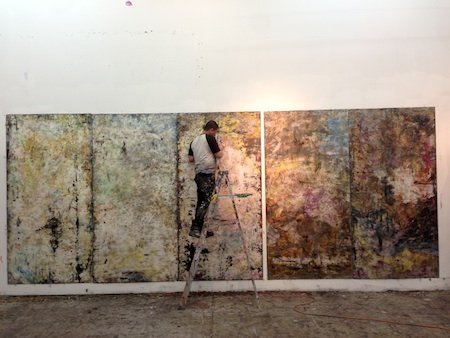
Yeah, I call the dried paintings "skins." It came from a reference about oil paint, flesh being the reason oil paint was invented. Painters, I think, recognize the physicality of oil paint specifically, how demanding it is, and how closely it can resemble our own bodies. Each of my paintings has a layer of skin.
THE INSPIRATION BEHIND THE APPROACH
It’s a way of dealing with the history of painting, and at the same time it’s a very materialistic and physical process. By using oil paint, you give a big hint about the history of painting—oil paint has been used by so many artists over so many centuries. At the same time, it’s such a challenged medium today. And it has so many references to the body, in terms of the brushstroke and so on. So, for me, it’s very important to use that specific medium.
JUSTIFYING THE MEDIUM 
People might wonder, "Why do I need to go from the traditional method to this more untraditional way of using paint?" I think painting just needs to be justified over time. There are periods of time where people will say that the medium is dead, or everything has been done. My process is a way of saying that there's another thing painting can do that no other method can accomplish. It's an approach that's very unique, but I think what's most important is that it makes a statement in a very historical context.
GIVING UP CONTROL
You don’t have complete control over it, so you can let painting be what it wants to be. The end results are totally unexpected. I accept some of them; other times they are not so interesting, and I usually retouch them, maybe to clarify areas that come out a little too saturated. But I don’t really touch them afterwards.
WHY POUSSIN? 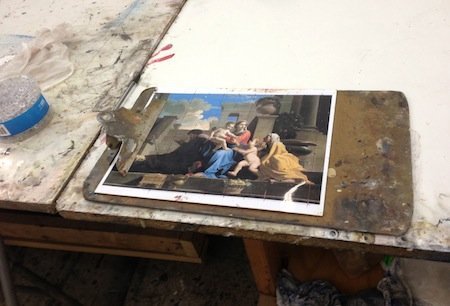
I’ve always been very physically attracted to painting, but I never really had things that I wanted to paint—I just had an impulse to paint. So sometimes I react to things that interest me as excuses for me to execute paintings, and it was actually through Cy Twombly that I got introduced to Poussin, and I became drawn to him for many personal reasons, like the relationship between things I'm thinking about and the subjects of his paintings, and also his use of color, his relationship to painting as an action, and then painting as a way of gaining this… well, when you paint religious subject matter and put your best efforts toward that, you hope to be elevated by it. He went through a lot of issues with his own personal impulses towards painting and what his patrons wanted him to paint, and he constantly fought with figures in his work. He took them from Greek sculptures because he didn't really knew how to paint figures that well.
WHAT HIS COLLECTORS NEVER SEE
I don’t reveal too much about the initial stage of the painting process. I might say which painting inspired it or which artist, and I do photograph it it in stages, but I don't share this information that much, to be honest. The finished painting is the result of the whole process. But it’s important to know the process of it and where it comes from. In the end, you may be able to see a little bit of art history, but it’s difficult to recognize. With this one, for instance, I can’t remember what it was based on from looking at it.
EXPERIMENTING WITH SCULPTURE 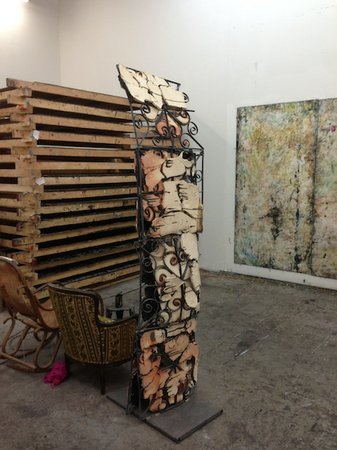
In the studio, I like exploring a lot, and I trust my ignorance sometimes. I’m constantly trying things that I don’t necessarily have a lot of experience with just to see where it'll take me, and to react to those impulses. Although everything is some sort of prediction of what’s coming next, I’m still constantly trying to mess up things in a good way. Since, as I've said, I’ve always been attracted to art in a more physical way, I wanted to try other mediums after finishing these paintings without really having a lot of knowledge of them. Porcelain was the first one.
THE PROCESS BEHIND HIS NEW SCULPTURES
These are porcelain and cast iron. Some of them I make them with gates I find at good antique stores, some of them are made from scratch. They have to have different surfaces. I clean them first—sandblast them and stuff—and I cut them in sections because they don’t fit completely in the kiln. Then the sections are filled with porcelain and I burn the porcelain and iron in the kiln together so they come out all distorted because of the temperature. When they come out I re-weld them, so the gate turns out even more distorted.
ON THEIR PERSONAL SIGNIFICANCE 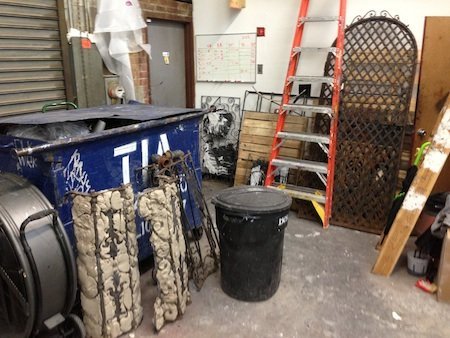
The gates have similar patterns to the one outside the house where I grew up in Puerto Rico. So it's really a little bit about my background—it's more of a personal reference. The gates were used over the windows on our balcony area for protection when people would try to break in. They use it here in New York, obviously, it’s not just a Puerto Rican thing—but this kind of pattern is very common. It’s like, “OK, we’ve got to protect ourselves, but let’s try to be a little cool at the same time.” It has some elegance.
RELATED LINKS:
Watch a video interview with Angel Otero on the legacy of Abstract Expressionism











